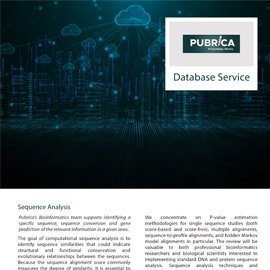Sequence Analysis
Pubrica’s Bioinformatics team supports identifying a specific sequence, sequence conversion and gene prediction of the relevant information in a given area.
The goal of computational sequence analysis is to identify sequence similarities that could indicate structural and functional conservation and evolutionary relationships between the sequences. Because the sequence alignment score commonly measures the degree of similarity, it is essential to understand whether a score is high enough to indicate a physiologically relevant alignment. The examination of the statistical significance of alignments is a reliable way of determining score cutoffs. The importance of an alignment score is often determined by its P-value, which is the probability that this score or a higher one might happen by chance, given the probabilistic models for the sequences.
P-value estimations of broad function in sequence analysis, as well as a discussion of theoretical methodologies and computer approaches for estimating statistical significance for significant kinds of sequence analysis problems. We concentrate on P-value estimation methodologies for single sequence studies (both score-based and score-free), multiple alignments, sequence-to-profile alignments, and hidden Markov model alignments in particular. The review will be valuable to both professional bioinformatics researchers and biological scientists interested in implementing standard DNA and protein sequence analysis. Sequence analysis techniques and databases can be used to identify genes and functional components in newly sequenced genomes. Computational sequence analysis also provides a foundation for the rapidly emerging subject of systems biology. It may anticipate protein-protein interactions and interactions in transcriptional regularity networks using sequence comparison and motif analysis approach.
Our comprehensive Bioinformatics Database services
Types of Bioinformatics: We undertake different types of Sequence analysis for gene sequence search, Protein sequence Analysis for your particular research work.
Wide range of Sources: NCBI, BLAST, Pubmed, Pubmed Nucleotide, Pubmed Protein, Pubmed Gene, Pubmed Sequence.
Let experts support you’re Bioinformatics Research.
We’ll scale
up as your needs grow.
No compromising on integrity and quality. Our processes are well defined and flexible to ramp up as per your requirements.
Partnering with
you till the project end.
We come with you all the way. From design to market support

Pubrica Offerings
Pubrica provides comprehensive bioinformatics research work publishing assistance for various publications, journals, and books. With our writing services, you can now turn your ideas into Project writing, Proposal writing, Research Writing, Thesis writing and Manuscript writing. Science, Technology, Engineering, and Mathematics (STEM) experts with a therapeutic background. It is now simple to publish a research work or obtain regulatory drug approval. With Pubrica's help, you can save time and money.
Frequently asked questions
We are with you the whole nine yards. In this section, we answer the tough questions. For any information, contact us via +91-9884350006 meanwhile, here are some of those queries
A biological database is a well-organized collection of persistent data typically enhanced by biologically relevant data, such as genomic sequences of a rapidly increasing number of organisms.
Biological databases can retrieve structures, binding locations, metabolic connections, molecular action, functional correlations, protein families, motifs, and homologous sequences. A biological databases main objective is to store and manage biological data and information in computer-readable formats.
Archieval databases are also known as primary databases. They are filled with data produced from experiments, such as nucleotide sequences, protein sequences, and macromolecular structures. Researchers enter experimental results directly into the database, and the data is virtually archival.
Bioinformatics tools aid in the comparison, analysis, and interpretation of genetic and genomic data, as well as the comprehension of molecular biology evolutionary aspects in general. It aids in researching and categorizing biological pathways and networks that are essential parts of systems biology more integrated.
A sequence database is a sort of biological database made up of an infinite collection of computerized ("digital") nucleic acid sequences, protein sequences, or other polymer sequences maintained on a computer in the field of bioinformatics. A protein sequence database such as the UniProt database is an example.


